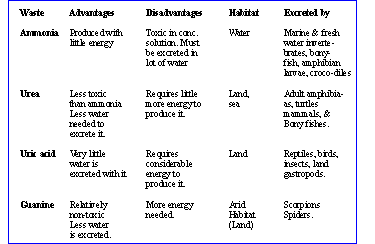|
PinkMonkey Online Study Guide-Biology
19.1 Ammonotelism, Ureotelism and Uricotelism
Nitrogen is a major constituent of amino acids
and proteins. Generally animals receive excess of amino acids through
their diet. The excess of amino acid is catabolized either for release
of energy or is used for the synthesis of glycogen and fat. When proteins,
amino acids or nucleic acids are catabolized, 3-nitrogen-containing predominant
excretory end-products are formed ammonia, urea and uric
acid.
(A) Ammonotelism. Animals that excrete excess
nitrogen in the form of ammonia (NH3) (the end product of protein
metabolism) are called ammonotelic. Ammonia diffuses through the cell
membrane extremely fast because of its high water solubility and small
molecular size. Therefore, prompt excretion of ammonia occurs in aquatic
animals (aquatic invertebrates, fishes, larvae, permanently aquatic amphibia).
The route of ammonia diffusion in these animals is through skin, gills
or kidneys.
(B) Ureotelism. Animals that excrete excess nitrogen
in the form of urea are ureotelic. Terrestrial animals cannot use water
freely for excretion (because of less availability in the environment),
so ammonia is converted into a less toxic and easily soluble product,
urea. In mammals and semi-terrestrial adult amphibians, urea is a major
nitrogenous excretory product, therefore these animals are called ureotelic.
Advantages And Disadvantages of Nitrogenous Wastes In Relation to Habitat

Click here to enlarge
(C) Uricotelism. Animals that excrete a major
portion of nitrogenous waste in the form of semi-solid or solid uric acid
are called uricotelic animals (e.g. birds, lizards, snakes, terrestrial
insects, snails.) In these animals ammonia is converted into less toxic,
relatively insoluble uric acid, which can be excreted with a relatively
small amount of water. Arachnids (e.g. spiders, scorpions, etc.) excreted
mostly guanine and hence are said to be guanotelic. The
above terms apply to the predominant form of excretory product, but do
not exclude the excretion of other forms in minor quantities.
[next page]
|
Table of Contents
19.0 -
Introduction
19.1 -
Ammonotelism, Ureotelism and Uricotelism
19.2 -
Excretory System of Man
19.3 -
Skin and Lungs as Accessory Excretory Organs
Chapter
20
|